“Big Torroids and Bigger Dents”
Based on a true story by Bill Ritenour included in the “EMC
War Stories” video memorial tribute to Donald R. Bush.
The electrical product safety guys keep telling me that EMI
really isn’t dangerous. Why do I keep hearing these kinds
of stories then? Early in his career, Bill Ritenour, now of
EMC Compliance LLC, was called to fix a potentially dangerous
problem at a railroad-switching yard. At this particular rail
yard, individual cars were taken to a high point and then
released down a sorting line. As the cars traveled down the
line, they were sorted onto appropriate spur lines, which
were used to assemble various trains. All of the rail car
sorting was coordinated from control centers along the line
via 2-way radio (more about the control center buildings later).
Inside, the switch controllers awaited commands to switch
this car here or that car there. The problem was that radio
communications were being seriously interfered with. If the
controllers could not communicate, railcars could go left
when they were supposed to go right. The cattle bound for
Cleveland might be misrouted onto the midnight train bound
for Milwaukee. And the poor guys in the command posts were
in harms way. Each control center building was protected by
an external ‘frame’ constructed of railroad rails,
closely welded together. Bill noted that several of these
protective ‘frames’ had very large dents in them.
He realized then why rail yard management wanted to be certain
of exactly where the rail cars (pilot less, massive, rolling
projectiles) were headed.
What was causing all of this potential mishap and mayhem?
Electromagnetic interference, of course. The printers operating
in the control centers were emitting a harmonic that was jamming
the 2-way radios. It was determined further that a problem
was coming off of the power cords. The fix was simple, a large
torroid installed on the power cable, and widely adopted by
the railroad company. You see, Bill received a call from a
ferrite salesman a few weeks later thanking him for the referral
on an order of a thousand large torroids. It seems that rail
company management was so impressed with the fix that torroids
were installed on every printer in the company. Well, its
pays to be overly cautious when dealing with dangerous levels
of EMI. |
Atlanta
A meeting was held on Tuesday, August 24, 2004 at the offices
of Altea Therapeutics. The speaker for the evening was Greg Conley
of Technical Systems Integrators based in Casselberry, Florida.
Greg gave an introduction to Mentor Graphics Hyperlynx software
for PCB radiated EMI prediction. The attendees learned that the
basic Hyperlynx software accepts PCB layout data and performs
post-layout verification. It is effective for clock and edge rates
up to about 1 GHz. Also available are crosstalk and EMC modules.
This appeared to be a valuable tool that was of interest to those
in attendance. Before Greg’s presentation, there was time
for networking and a pizza dinner. On May 20th, 2004, Dortch Walker,
Field Applications Engineer with Rohde & Schwarz, spoke on
“EMI Receivers vs. Spectrum Analyzers in EMI/EMC Applications.”
This presentation dealt with the differences between test receivers
and spectrum analyzers and the proper application of both in EMI/EMC
testing. On March 16, 2004, the industry renowned Daryl Gerke
of Kimmel Gerke Consultants, out of Phoenix, Arizona, spoke to
our group. The topic was, “How to Design to Fail FCC and
CE Tests... in 20 Easy Steps.” It was a light-hearted look
at 20 common EMI problems from a different perspective. As the
old saying goes, “Oscillators won’t, but amplifiers
will.” What if we turned things around, and actually tried
to fail EMI tests. This approach got a lot of chuckles, and the
group got into the spirit by adding further suggestions. Daryl's
talk provided some good technical information on EMI. The Chapter
and the participants are indebted to Daryl for his fun and informative
presentation and all who took advantage thanked him. For more
about ‘what’s up’ with this Chapter, visit them
online at https://www.ewh.ieee.org/soc/emcs/atl/atl-emc.htm
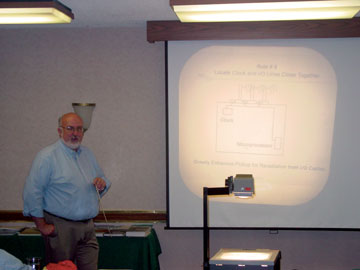 |
| Daryl Gerke during his “How
to Design to Fail FCC and CE Tests in 20 Easy Steps”
presentation to the Atlanta Chapter in March. |
Israel
Moshe Netzer reports that the Israel Chapter held a meeting on
July 9, 2004. Nine people, including several student members and
Chapter guests, attended the gathering. Three separate presentations
where made at the unusually small meeting. First, Moshe Netzer
of Rafael discussed “A Graphical Method for the Estimation
of Radiation Hazards from a Crowded Multiple Antenna Site.”
Next, D. Razansky, D. F. Soldea, G. Yankilevich and P. D. Einziger
gave a paper entitled, “Estimates on Electromagnetic Power
Absorption in Highly-Lossy Configurations.” Finally, Moshe
Netzer spoke on the topic of “Graphical Presentation of 50/60
Hz Magnetic Field Contours as an Engineering Tool for Minimizing
ELF Fields.”
Nanjing
Wen Xun Zhang, Chapter Chair, reports that the Nanjing EMC Chapter
was very busy with meetings the past few months. Back in August,
the Nanjing Chapter had a great seven-day run of multiple meetings.
Beginning on August 25, Dr. Yang Hao of the Queen Mary College,
University of London presented on the topic of “Innovative
Antennas and Their Applications.” 34 IEEE members and guests
enjoyed Dr. Hao’s presentation. The very next day, the Chapter
held a meeting attended by 53 people, eager to hear Dr. Y.X. Guo
of the Institute for Infocomm Research speak about “Regular
and Miniature Wideband Microstrip Antennas for Wireless Communications.”
On August 27th, 32 attendees heard a presentation entitled, “The
Finite Element Method for Computational Electromagnetics: Recent
Progress, Current Status and Future Directions” by Prof.
Jian-Ming JIN of the University of Illinois at Urbana-Champlain.
The week’s biggest draw was on August 28th when 102 attendees
came to hear two presentations. The first was by Prof. Yahya Rahmat-Samii
of the University of California at Los Angeles (UCLA). Prof. Rahmat-Samii
spoke about “Electromagnetic Band Gap (EBG) Structures and
Meta-Materials in Antenna Engineering.” Next, Prof. Weng-Cho
Chew of the University of Illinois at Urbana-Champlain gave a
presentation to the packed house regarding “Introduction
to Fast Multi-pole Method for Electrodynamics.” To cap things
off, the Chapter organized the “Progress In Electromagnetics
Research Symposium (PIERS’04 at Nanjing) on August 29-31
at the opulent Zhongshan Hotel. 313 members and guests attended
the symposium. To wrap up their recent flurry of meetings, on
September 6th, the Chapter welcomed Prof. Yahya Rahmat-Samii of
the University of California at Los Angeles (UCLA) again as he
spoke on the topic of “Novel Antenna and Electromagnetic
Systems Design Using Evolutionary Optimization Techniques.”
Oregon and SW Washington
Sidney Chan, Chapter Vice-Chair, reports that the Oregon and SW
Washington Chapter kicked off another year of great meetings on
September 29th. This year the Chapter meetings are being held
at the University of Portland campus. Before the evening’s
business and presentation, everyone enjoyed a spaghetti dinner
with all the fixings. David Britton, Chapter Chair, introduced
the new officers and then introduced the speaker Jerry Ramie.
Mr. Ramie of ARC Technical Resources, Inc. presented a talk on
“EMC Testing of Substation Products”. Jerry Ramie is
a 24-year veteran of the regulatory compliance, EMC, and RF/Microwave
instrument businesses. Jerry gave a lively, fast paced presentation
with 96 slides. He introduced the topic by speaking on the threats
to power providers including radio noise interference, electromagnetic
sabotage, and reliability. He covered in depth the EMC standards
and test requirements for protective relays used in substations.
For more about ‘what’s up’ with this Chapter, visit
them online at: https://www.worldaccessnet.com/~emc/
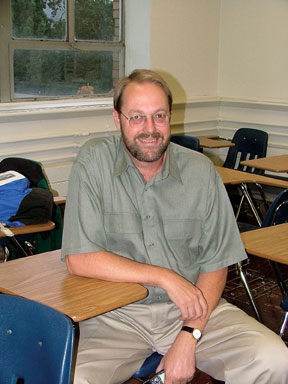 |
| Jerry Ramie of ARC Technical Resources,
Inc. relaxes before his presentation to the Oregon and SW
Washington Chapter. |
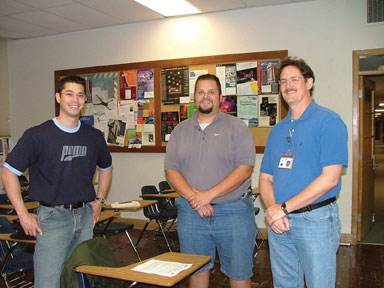 |
| Mitchell Phillipi of Logitech, Communications Director,
Derick Skouby of HP, Treasurer and Immediate Past Chair, and
Dave Britton of HP, Chapter Chair (from left) visited before
the Oregon and SW Washington Chapter meeting. |
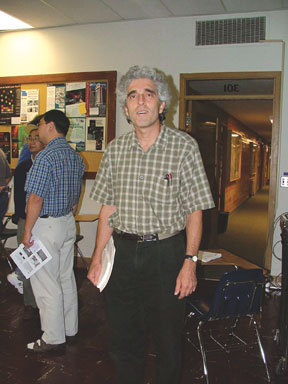 |
| Aziz Inan, Membership Director of
the Oregon and SW Washington Chapter. |
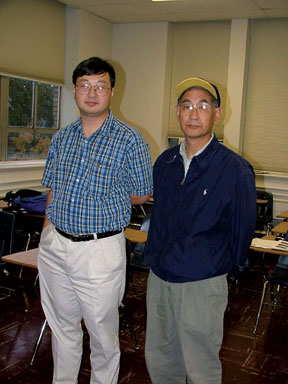 |
| Xiangying Ma (left) and Ting Ma from
Welch Allyn, Inc. attended the Oregon and SW Washington September
Chapter meeting held at Portland University. |
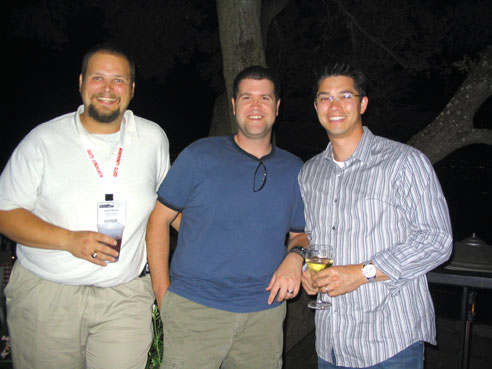 |
| The winery event held in Santa Clara
during the EMC Symposium week provided a great opportunity
for Oregon and SW Washington Chapter members (from left) Derick
Skouby of HP, Mark Ohnstad and Mitch Phillipi, both of Logitech,
to informally network. |
Rocky Mountain
Charles Grasso of the Rocky Mountain chapter reports that the
summer was busy with EMC meetings in Colorado! In June, the evening’s
presentation featured “An Overview of the Signal Integrity
Discipline.” To be involved with signal integrity design
is to be involved at the very heart of a product’s functional
operation. Without a systematic approach to signal integrity design,
a typical product design cycle can be lengthened dramatically
with iterative bench debug and, worse, erratic performance in
the field. This talk by Ian Dodd of Mentor Graphics provided an
overview of all the related design items that make up the signal
integrity discipline. It introduced first generation synchronous
timing analysis, setup and hold times, typical clock and edge
rates. The presentation then showed how well designed traces at
high frequencies act as transmission lines. He examined reflections
and provided a simple lattice diagram to illustrate his point.
Discontinuities (branches and stubs) with an introduction to parallel
and series termination were then discussed. The talk also included
what-if simulation analyzing simple net with imperfect terminations
(Mentor Expedition PCB with Signal Vision SI Analysis). We examined
how switching margins, ringing (overshoot and ring back), ground
bounce and power droop all affect the signal quality. In the second
half of the talk we were introduced to crosstalk, source synchronous
signaling, multi-drop buses, typical clock and edge rates and
the basics of transmission line losses and how they affect signal
quality. We also discussed dielectric and skin losses and their
significance at the clock speeds and examined the need to close
decoupling and power plan analysis at higher clock rates. The
need to occasionally use non-ideal return paths and how these
affect switching was discussed. The talk ended by examining multi-gigabit
differential signaling and a discussion of mid-frequency resonances
and an example why multi-cycle analysis is needed to see these
types of resonance effects. The examination of losses in high-speed
lines (shown with an eye diagram) revealed the increased effect
of losses and how pre-emphasis and compensation filters can be
used as a means to overcome losses. In July, Professor Michel
Ianoz gave the chapter an informative presentation on “The
Biological Effects of Electromagnetic Fields.” Professor
Ianoz discussed the sources of electromagnetic fields, which are
of concern for the population: power lines and mobile communications
(phones and antennas). He presented measured biological effects
of electric and magnetic fields (low frequency and high frequency)
and discussed possible effects on health. A research program initiated
in 1997 at the Swiss Federal Institute of Technology of Lausanne,
Switzerland to study the effects of low frequency magnetic fields
on very simple vegetable structures (mosses) and high frequency
effects on more complicated organisms like nematodes was also
discussed. A method based on fractals to evaluate the effects
was presented. In August, Ian Dodd discussed “Multi-Gigabit
Design - Design Challenges, Options, and Simulation Solutions”
with the Rocky Mountain Chapter. Ian’s presentation looked
into the high speed design challenge involved in new bus and I/O
designs and an overview of the multi-gigabit architecture was
presented. We discussed the reasons for moving to a multi gigabit
design and compared the new design challenges to the “traditional”
high-speed design. The design challenge of actually implementing
the multi gigabit design was presented with a review of the transmission
line physical parameters. We then looked at the final analysis
of the transmission line design, the eye diagram, and looked at
various ways to identify the problems and some options on improving
the signal quality. A review of the challenges in simulating the
printed circuit board performance was also presented. In September,
Bruce Archambeault of IBM gave a very helpful presentation entitled
“Maxwell’s Equations for the Working EMC Engineer.”
Understanding Maxwell’s equations has, typically, been the
sole domain of professors of electromagnetics and Masters degree
students. However, an intuitive understanding of these seminal
equations without all the messy math is often all that is needed
to properly design and debug electronic equipment. In this presentation,
Bruce stripped out all the messy math and examined each of the
equations and deciphered exactly what the weird symbols really
mean. Using simple examples, Bruce helped us apply our new knowledge
for a better understanding of how EM fields are created in electronic
designs with practical examples. No wonder Bruce is a Distinguished
Lecturer with the IEEE EMC Society!
 |
| Ian Dodd of Mentor Graphics (right)
discusses signal integrity with Otto Buhler (left) at the
Rocky Mountain Chapter meeting. That’s Chapter member
Monrad Monsen caught in the middle. |
 |
| Professor Michel Ianoz (standing)
discusses the shielding properties of copper with Bill Ritenour
(seated left) of the Rocky Mountain Chapter. |
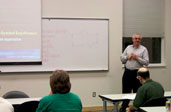 |
| Ian Dodd spoke to a rapt audience
at the Rocky Mountain Chapter’s August meeting. |
 |
| Bruce Archambeault demystifies voltage
gradients for the Rocky Mountain Chapter at their September
meeting. |
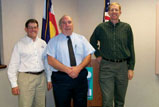 |
| Mat Aschenberg (left) and Monrad
Monsen (right) thank Bruce Archambeault for an excellent presentation
to the Rocky Mountain Chapter. |
Seattle
The Seattle EMC Chapter took the summer months off from holding
regular Chapter meetings. Instead, many Chapter members in August
attended the 2004 IEEE International Symposium on EMC held in
Santa Clara, California. While there, Chapter Chair Pat André
and Chapter Vice-Chair Janet O’Neil took the opportunity
to network with the officers from their sister EMC Chapter, the
Oregon and SW Washington Chapter. Together, these Chapter Officers
recruited speakers for future Chapter meetings during breaks in
the technical program, on the exhibit floor, and at the social
events organized by the Santa Clara Symposium Committee. As such,
an excellent technical program is planned for these Chapters during
their respective 2004/2005 technical program year. At its September
28 Chapter meeting, Jerry Ramie of ARC Technical Resources spoke
on the “EMC Testing of Substation Products”. This was
Jerry’s second visit to the Seattle EMC Chapter and his sharp
wit, lively presentation, and expertise were evident once again.
Coming up in October, the Chapter is looking forward to a presentation
by EMCS Distinguished Lecturer Tom Jerse of The Citadel. In November,
Elya Joffe of KTM Project Engineering in Israel will visit to
give a presentation on Electrophobia. This promises to be an exciting
fall line up of speakers. For more information on the activities
of the Seattle EMC Chapter, please visit the IEEE Seattle Section
website at www.ieee-seattle.org.
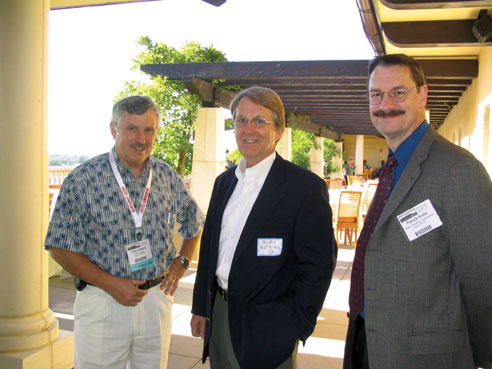 |
| Seattle EMC Chapter Chair, Pat André
of André Consulting, (far right) worked the many events
held during the Santa Clara symposium to recruit speakers
for future chapter meetings. “Innocent victims”
included Dave Seabury and Glen Watkins (from left) of ETS-Lindgren. |
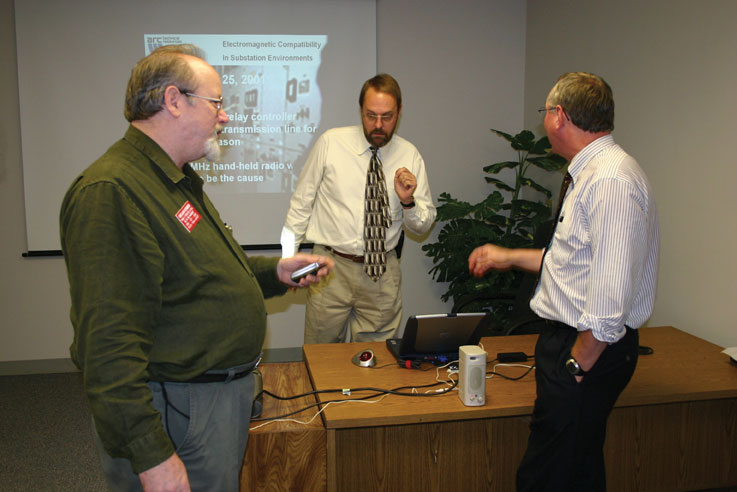 |
| Speaker Jerry Ramie (center) is stumped
by a question following his presentation at the September
Seattle EMC Chapter meeting. |
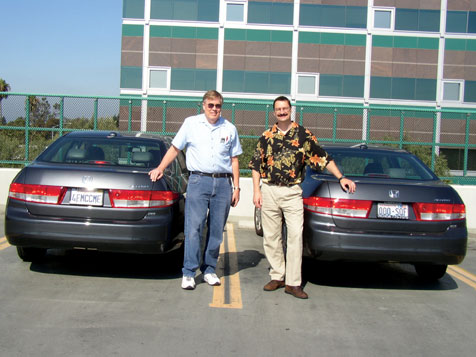 |
| EMC Consultants Steve Jensen (left)
and Pat André (Seattle EMC Chapter Chair) learned in
Santa Clara that they have more in common than just EMC, they
each drive identical vehicles! Note Steve’s license plate! |
SE Michigan
The SE Michigan EMC Chapter held a two-day workshop on September
14 and 15 entitled “Reverberation Chambers for EMC Testing.”
The workshop was designed for the automotive EMC community and
held at EST Testing Solutions in Plymouth, Michigan. Speakers
included reverberation chamber industry guru, Michael O. Hatfield,
from the Naval Surface Warfare Center in Dahlgren, Virginia. Mr.
Hatfield started the workshop with a three-hour presentation on
the history and evolution of reverberation chamber testing methodology.
He explained that no one would deny that today’s automobiles
and vehicles are using more electronics than ever, and all agree
that the trend will continue for the foreseeable future. As a
consequence, within the automotive industry there must be a continual
emphasis to identify cost effective EM test techniques that also
maintain high accuracy (lower uncertainties). This is especially
true for large vehicles such as tractors, combines, busses, etc.
The traditional approach has been that as the number of “boxes”
increases, the number of tests that must be conducted increases
(which increases costs). In addition, as electronics are being
used for more critical vehicle control functions, the test methods
must also maintain their thoroughness. Past methods of testing
have utilized the anechoic chamber. Mr. Hatfield advised that
this workshop would discuss the use of the reverberation chamber
to meet these new demands as an effective alternative to the anechoic
chamber techniques. Speakers Terry North and Andrew Shune of DaimlerChrysler
followed Mr. Hatfield’s presentation with a summary of the
test techniques utilized by DaimlerChrysler with reverberation
chambers, both now and planned usage for the future. Speakers
Laura Ball and Kevin Pender of General Motors concluded the first
day of the workshop with an overview of the test techniques utilized
by General Motors with reverberation chambers, both now and planned
usage for the future. They included an overview of the standard
GMW3097 Rev 4 Reverberation Emissions Testing and Mode Stir Testing.
Many questions followed this presentation. The following day,
the “Practical Usage of Reverberation Chamber Testing Methodology”
was presented. Garth D’Abreu of ETS-Lindgren started the
day with a presentation on how to specify a reverberation chamber.
He reviewed the cost versus benefits of this type of testing,
the challenges still to be addressed, design and performance trade-offs,
the theoretical basis for using reverberation chambers, the parameters
used in the standards, and the development of pulse modulation,
among other topics. Sean Emerson of Rohde & Schwarz was the
second speaker. His presentation addressed the software and test
measurement instrumentation needed for efficiently and cost effectively
performing reverberation chamber testing. Mike Hatfield then concluded
the workshop with a summary of what had been presented. Lastly,
he discussed future considerations for reverberation chamber testing,
including the existing and expected direction various EMC standards
will take globally on this type of testing. Over 70 Chapter members
and guests attended this two-day workshop, some from as far away
as Atlanta. In addition to hearing several excellent presentations
by industry experts on the topic, all were able to tour the new
reverberation chamber on site at EST and witness hands-on testing.
SE Michigan Chapter Chair Scott Lytle was very enthusiastic about
the positive response to the quality of the workshop. He particularly
acknowledged the assistance of the staff at EST, including Steve
English and Donna Wenzel, who handled the logistics of the event.
Chapter Treasurer Graeme Rogerson did an outstanding job of ordering
the excellent food from Buster’s Barbeque served during lunch
each day, as well as the tables and chairs brought in for the
“classroom” style seating. Janet O’Neil of ETS-Lindgren
coordinated the technical program and provided the handouts of
speaker’s presentation slides. Phil Dew raided his office
and provided lots of “freebies” for the attendees to
take home, including coffee mugs and bags from Rohde & Schwarz
as well as mouse pads from AR Worldwide and more! Kimball Williams
of UL, Chapter Secretary, concluded the workshop by thanking the
speakers for generously donating their time and talents, as well
as the staff at EST, including Steve Dykstra, President, for allowing
the Chapter to take over their facility for two days of IEEE EMC
educational activity.
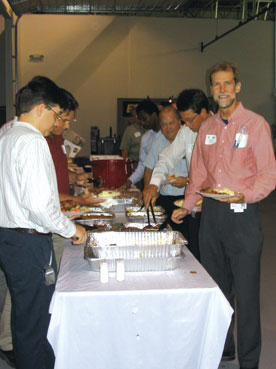 |
| Bill Owsley of Underwriters Laboratories
(right) enjoys the buffet barbecue lunch offered during the
SE Michigan Chapter’s Reverberation Chamber Workshop
on September 14-15. |
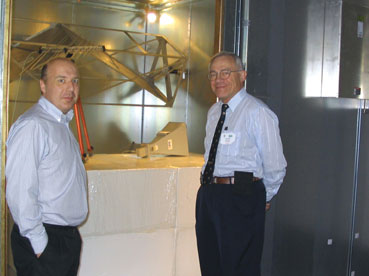 |
| During a break in the Reverberation
Chamber Workshop, Steve English of EST Testing Solutions (left)
showed speaker Terry North of DaimlerChrysler their new reverberation
chamber. |
 |
| Michael Natale and Thomas Arcati
of Dayton T. Brown journeyed from Bohemia, New York to attend
the Reverberation Chamber Workshop organized by SE Michigan
Chapter Chair Scott Lytle of Yazaki North America (from left)
and his committee. |
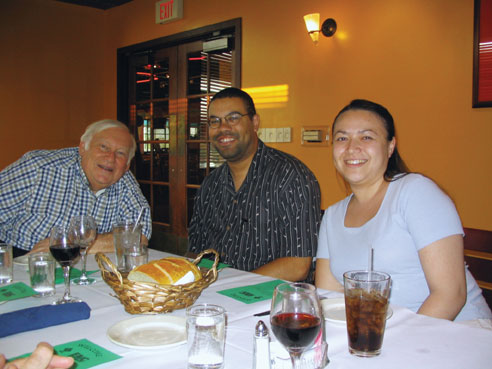 |
| A dinner was held by the SE Michigan
Chapter following the first day of the Reverberation Chamber
Workshop to thank the speakers for donating their time and
talents to the technical program. GM’s Bill Sperber (recently
retired), Kevin Pender, and Laura Ball (from left) enjoyed
the Italian-Greek dinner at Ginopolis Restaurant. |
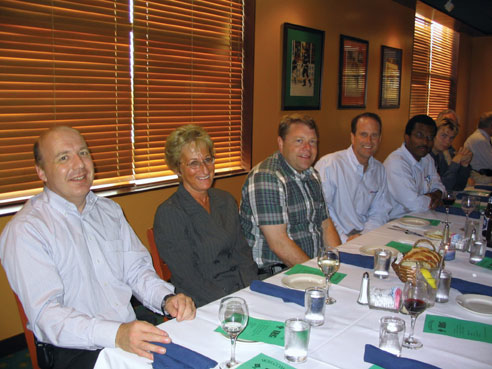 |
| Also enjoying the Ginopolis dinner
were (from left) Steve English and Donna Wenzel from EST Testing
Solutions, Mike Bosley of Visteon, Kevin Baldwin and Garth
D’Abreu of ETS-Lindgren, and Will Adams of the Naval
Surface Warfare Center in Dahlgren, Virginia. Donna and Steve
appreciated sitting down as they were kept hopping during
the Reverberation Chamber Workshop! |
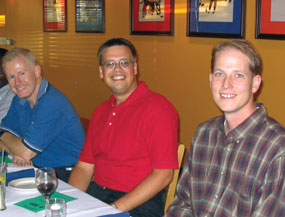 |
| Speaker Sean Emerson of Rohde &
Schwarz joined out-of-towners Chad Blueher and Eric Pratt
from Delphi of Kokomo, Indiana (from left) at the dinner following
the first day of the Reverberation Chamber Workshop. |
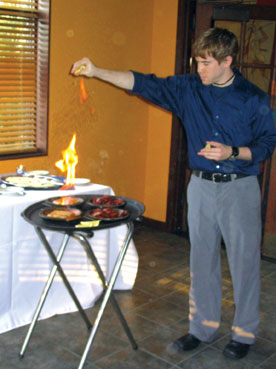 |
| The dinner celebrating the success
of the Reverberation Chamber Workshop began with Saganaki,
a flaming appetizer of Greek Kasseri cheese. Opa! |
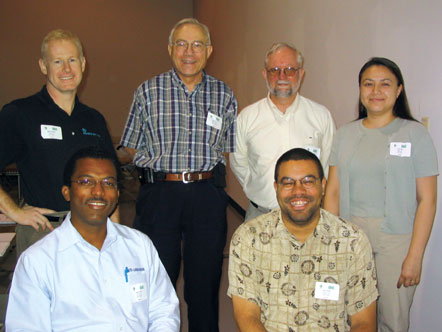 |
| The technical program at the Reverberation
Chamber Workshop was excellent thanks to the speakers, including
(front row from left) Garth D’Abreu of ETS-Lindgren,
Kevin Pender of GM, (back row from left) Sean Emerson of Rohde
& Schwarz, Terry North of DaimlerChrysler, keynote speaker
Mike Hatfield of the Naval Surface Warfare Center, and Laura
Ball of GM. |
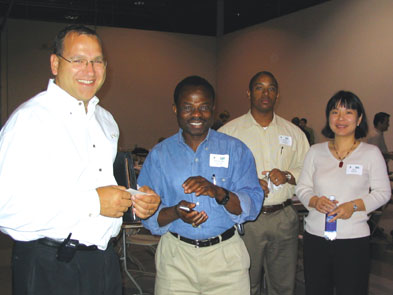 |
| Steve Dykstra, President of EST Testing
Solutions, thanked the folks from Panasonic Automotive Systems,
including Nee Salam, Jaive Peaks, and Janet Luo (from left)
for their travel from Atlanta to Michigan to attend the Reverberation
Chamber Workshop at his facility. |
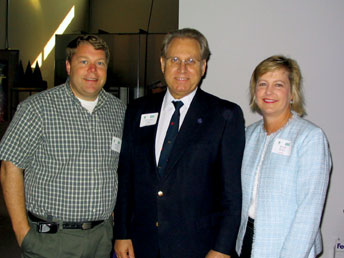 |
| Mike Bosley of Visteon, SE Michigan
Chapter Secretary Kimball Williams of UL and Janet O’Neil
of ETS-Lindgren visited during the Reverberation Chamber Workshop. |
 |
| Dan Wheeler of Michigan Scientific,
Roger Goetz of Lear Corporation, Doug Kane of Michigan Scientific,
and SE Michigan Chapter Treasurer Graeme Rogerson (from left)
are shown checking out the EST Testing Solutions penguin “mascot”
during a break at the Reverberation Chamber Workshop. |
Southern Brazil
The Southern Brazil EMC Chapter held a two day EMC Colloquium
and Exhibition at the Laboratório de Integração
e Testes (LIT) at INPE (Brazilian Space Agency) in São
José dos Campos on September 30 and October 1. EMCS Board
member Carlos Sartori with the University of São Paulo,
Brazil and Janet O’Neil, EMCS Region 9 Conference Coordinator,
organized this event with the assistance of Roberto Menna Barreto
with QUEMC in Rio de Janeiro and the staff at INPE, including
Benjamim Galvao and Margarete Toledo. This was an exceptional
event due to the outstanding facility where it was held, the generous
and gracious hospitality of the staff at INPE, and the quality
of the technical program. Leading speakers from the United States
included Dan Hoolihan of Hoolihan EMC Consulting, Todd Hubing
of the University of Missouri at Rolla, and Mark Steffka of General
Motors. These speakers addressed medical, printed circuit board,
and automotive EMC issues, respectively. In addition, Mr. Hoolihan
gave a presentation on aerospace EMC and related standards. Local
speakers Roberto Menna Barreto and Benjamim Galvao, who discussed
the challenge of EMC to Brazilian industries and the EMC/EMI test
resources at INPE, respectively, complemented this technical program.
Carlos Sartori gave a presentation on the IEEE worldwide and the
EMC Society in Brazil. Rounding out the technical program were
Vince Rodriguez and Dave Seabury of ETS-Lindgren who gave presentations
on an introduction to RF anechoic chambers and specific absorption
rate (SAR) concepts and regulatory considerations, respectively.
The colloquium and exhibition was held in the brand new auditorium
at INPE. This was, in fact, the inaugural event to be held there.
It featured state of the art audio-visual capabilities and acoustics.
The two-day colloquium and exhibition began with a welcome cocktail
reception on September 29. The world famous Brazilian cocktail,
the caipirinha, quickly became everyone’s drink of choice.
The next day, Clovis Solano Pereira, the head of LIT/INPE, personally
welcomed everyone to the conference. This was followed by a series
of technical presentations after a very unique continental breakfast
with many varieties of pastries, juices and strong Brazilian coffee.
Breaks in the technical presentations afforded attendees time
to visit the small exhibition showcasing companies Rohde &
Schwarz, ETS-Lindgren, Credence Technologies, and IME (representing
TDK and AR Worldwide, among others). For lunch, attendees boarded
a motor coach to travel 20 minutes into the countryside for an
authentic Brazilian meal on a ranch with a very scenic lake. After
the day’s presentations, Benjamim Galvao, head of the EMC
lab at LIT/INPE, took everyone on a tour of INPE’s EMC laboratory.
The highlight was seeing their new RF anechoic chamber, which
measures 28.3m x 15.07m x 11.54m and features a 9.0m diameter
turntable. The day concluded with a gala dinner outdoors on the
INPE campus, featuring an incredible buffet of wonderful food
and live musical entertainment. On Friday, October 1, the attendees
enjoyed yet another sumptuous continental breakfast and stimulating
technical presentations. Lunch on this day was at a traditional
Brazilian churrascaria nearby, featuring a wide variety of meat
carved tableside. At the end of the day, following the last presentation,
all agreed it was a successful IEEE EMC Society conference in
Brazil. Many friendships were formed amongst the EMC engineers
present from the US, Brazil, Uruguay, and Argentina.
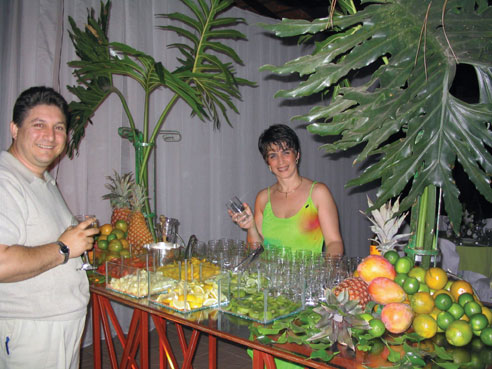 |
| Toni Gurga of Credence Technologies
enjoys the exotic fruit drinks that Margarete Toledo of INPE
offered at the “Welcome Cocktail Reception” held
the night before EMC Brazil 2004. |
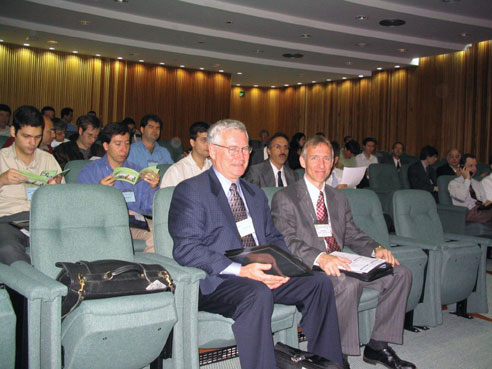 |
| Speakers Dan Hoolihan and Todd
Hubing ready themselves for a great day of technical presentations
in the new auditorium at EMC Brazil 2004. |
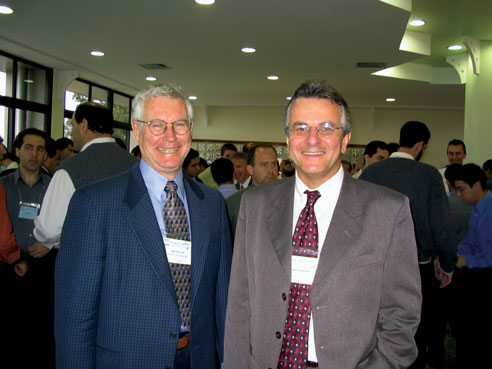 |
| Speakers Dan Hoolihan (left) and
Carlos Sartori visited in the exhibition area during a break
in the EMC Brazil 2004 technical program. Note the many people
in the background that attended this conference. |
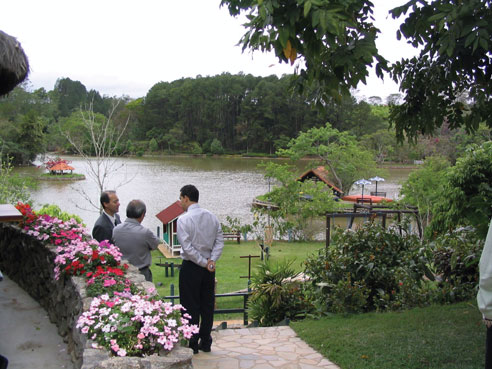 |
| Lunch on the first day of EMC Brazil
2004 was held at a ranch near São José dos Campos.
Several attendees dined outside near the beautiful scenic
lake on the property. |
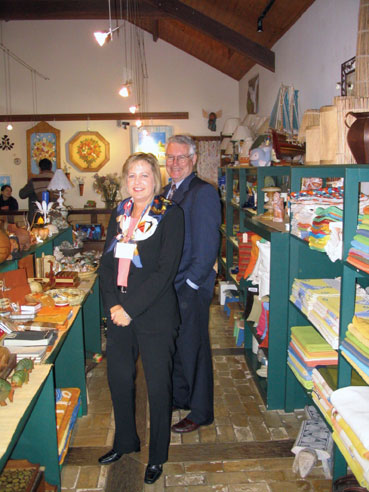 |
| Following lunch at the ranch, some
of the EMC Brazil 2004 attendees, including Janet O’Neil
and Dan Hoolihan, visited the gift shop nearby to see the
many traditional Brazilian arts and crafts on display. |
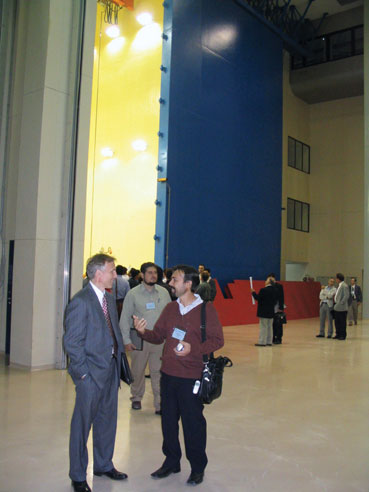 |
| The first day of EMC Brazil 2004
concluded with a tour of the large EMC test laboratory at
INPE. Many attendees found this to be a good time to talk
with speaker Todd Hubing (far left) who had just concluded
his presentation before the tour. |
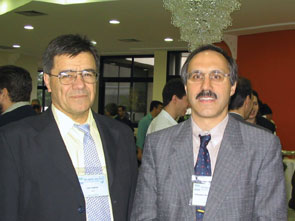 |
| EMC Brazil 2004 attendees Luis Garcia
of the Instituto Nacional de Tecnologia Industrial (left)
and Fernando Hernandez Sanchez of URSEC appreciated having
an IEEE EMC event in South America. Congratulations to Fernando
who recently obtained Senior Member status in the IEEE EMC
Society! |
 |
| Achim Gerstner of Rohde & Schwarz,
Clovis Solano Pereira, head of LIT/INPE, and Todd Hubing of
the University of Missouri at Rolla (from left) enjoyed a
caipirinha at lunch on the second day of EMC Brazil 2004. |
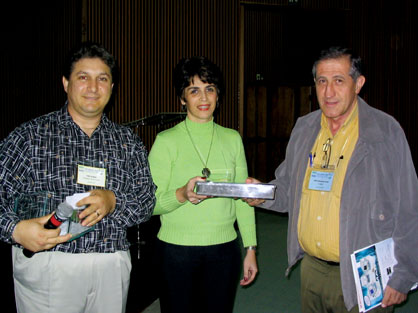 |
| Toni Gurga of Credence Technologies
(left) provided raffle items at the conclusion of EMC Brazil
2004. Margarete Toledo drew the winning business card of Joao
Batista Carvalho Filho of Avibras (right) for a Ferri-Shield
ferrite kit. |
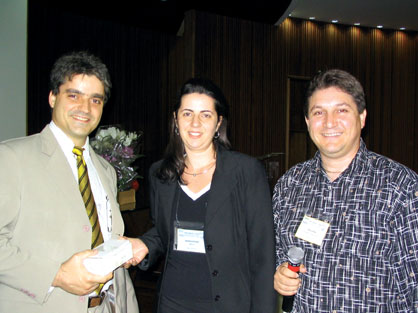 |
| Fernando Mauro Macedo Teixeira of
Volkswagen Caminhoes e Onibus (left) received a probe from
Credence Technologies following EMC Brazil 2004. Sandra Regina
de Paula of INPE drew the winning business card much to the
delight of Toni Gurga (right). |
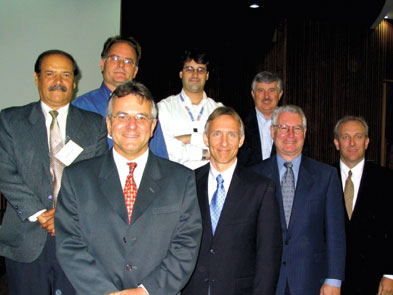 |
| The speakers at EMC Brazil 2004 gathered
at the conclusion of the two-day event, including (front row
from left) Carlos Sartori, Todd Hubing, Dan Hoolihan, Mark
Steffka, (back row from left) Benjamim Galvao, Roberto Menna
Barreto, Vince Rodriguez, and David Seabury. |
Washington, DC/Northern Virginia
Mike Violette reports that the Washington/Northern Virginia Chapter
met at Blackie’s House of Beef in Washington DC on September
16th. Fifteen attendees listened to Dr. Bill Duff’s presentation
on “Interference of Ultrawideband Emitters to Radio Receivers.”
The Washington, DC/Northern Virginia Chapter is getting ready
to elect a new set of officers and is planning to host a local
one-day EMC event in the fall of 2005. Members in the Washington
DC area are encouraged to contact Mike Violette (mikev@wll.com)
for more information. The next meeting will be at the Naval Research
Laboratories in Washington DC, on January 27, 2005. New officers
will be in place and the planning for 2005 will be underway. EMC
|
|
|